
- Index
- Age
- Brand
- 21st Century Toys (12)
- Alert Line (18)
- Army (10)
- Arsa (10)
- Bolt Action (9)
- Buren (6)
- Did (15)
- Doxa (7)
- Dragon (33)
- Dragon Models (6)
- Forces Of Valor (24)
- Glycine (8)
- Handmade (43)
- Helvetia (19)
- King & Country (42)
- No Brand (7)
- Record (6)
- Ultimate Soldier (11)
- Warlord Games (21)
- Zenith (12)
- Other (3469)
- Conflict
- Style
- Antique (10)
- Army (8)
- Army Cap (2)
- Bomber Jacket (3)
- Casual (2)
- Leather Belt Holster (9)
- Leather Flap Holster (4)
- Luxury: Dress Styles (6)
- Military (160)
- Military Jacket (14)
- Military, Vintage (2)
- Motorcycle Jacket (7)
- Original (2)
- Overcoat (5)
- Pea Coat (2)
- Pendant (2)
- Signet (6)
- Trench Coat (7)
- Vintage (11)
- Wwii (2)
- Other (3524)
- Theme
- Type
- Action Figure (77)
- Badges (13)
- Binoculars (32)
- Boot (11)
- Coat (87)
- Equipment (11)
- Field Gear (159)
- Hat / Cap (51)
- Helmet (18)
- Jacket (101)
- Medals & Ribbons (11)
- Personal Gear (73)
- Pocket Watch (11)
- Ring (18)
- Soldier (16)
- Tactical Sling (26)
- Tank (36)
- Uniform (41)
- Uniform / Clothing (119)
- Wristwatch (109)
- Other (2768)
WWII 1944 German Army Attack Bomber Henschel Hs-129 W. E. F. T. U. P. ID Poster
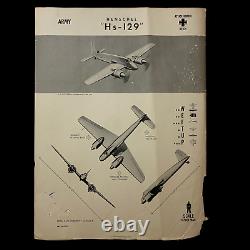
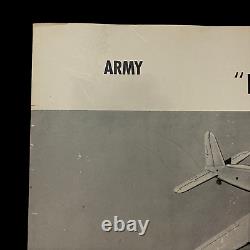
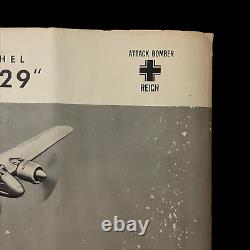
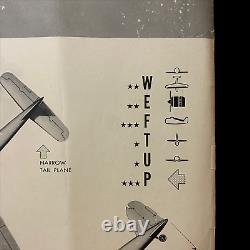
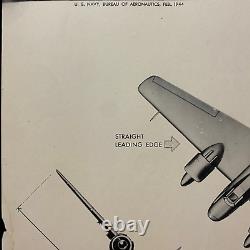
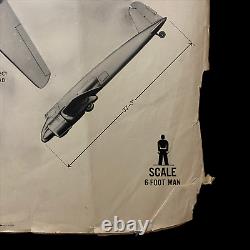
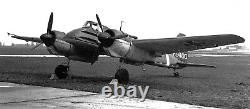


Size: 19 x 25 inches. This original'RESTRICTED' aircraft identification poster was published by the U. Naval Aviation Training Division Feb 1944.
This poster was posted as a training tool as well as an in theater ID poster to help U. And other Allied pilots, bomber crews and Naval personal to identify Allied and enemy aircraft. Or Wing, Engine, Fuselage, Tail, Undercarriage, Peculiarities was a system set up for the purpose of aircraft identification and recognition.
World War II saw some of the first introduction of these aircraft ID poster to prevent friendly fire and more accurate plane recognition in combat. It was believed these posters alone could save countless lives from friendly aircraft-on-aircraft or friendly anit-aircraft fire. These posters also could cut down precious second pilots, bomber gunners, and naval gun crews would have to ID a plane flying towards them intern saving their lives by shooting first. Each poster provides the silhouettes, dimensions, and relevant information to educate both air and ground personnel in aircraft identification. Immediate identification of aircraft, friendly or not, was essential in order for the observer whether in the air e.Pilot, gunner, or patrol observer, or on the ground, e. Anti-aircraft crew to determine his next course of action e. Acknowledge, attack, evade, or report. Each poster details a large clean sky and background image of the specified aircraft located as the main top imagine on the poster.
It also contains important'peculiarities' such as where certain gun emplacements are located, other special aircraft features, as well as wing and length measurements. The Henschel Hs 129 was a World War II ground-attack aircraft fielded by the German Luftwaffe. The aircraft saw combat in Tunisia and on the Eastern Front.
A key requirement of the original specification was that the aircraft be powered by engines that were not in demand for other designs. Prototypes with low-power German Argus As 410 engines of 465 PS (459 hp; 342 kW) failed acceptance test, a more powerful replacement was found with the French Gnome-Rhône 14M engine of 700 PS (690 hp; 515 kW). The design was relatively effective when it was first introduced, and saw service on the Eastern Front in a variety of front-line roles.
As the war continued and anti-tank support became the main goal, the aircraft was continually up-gunned, eventually mounting a 75 mm gun in the anti-tank role that left the plane barely flyable. Only a small number of these B-3 models were produced, late in the war.

